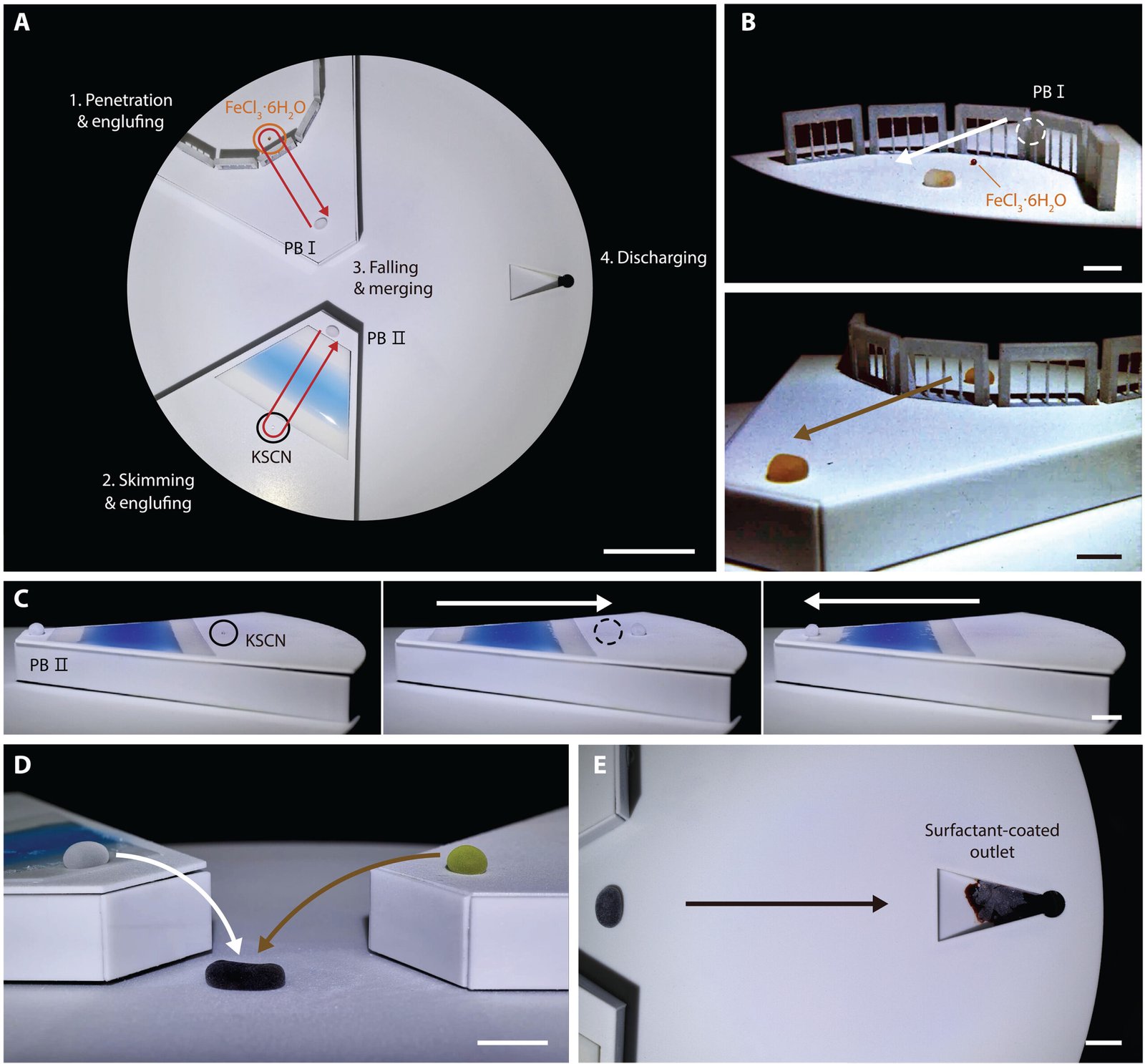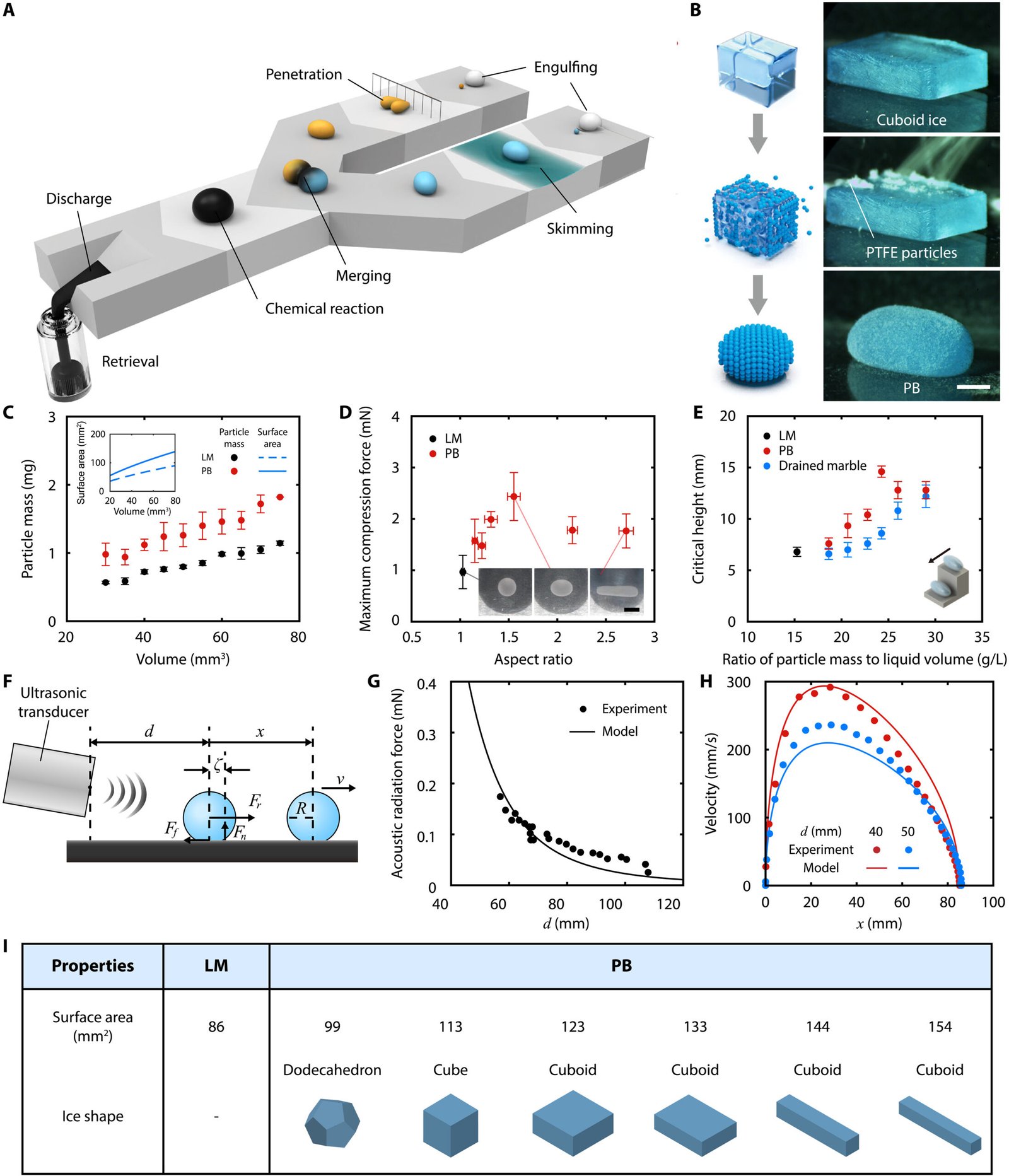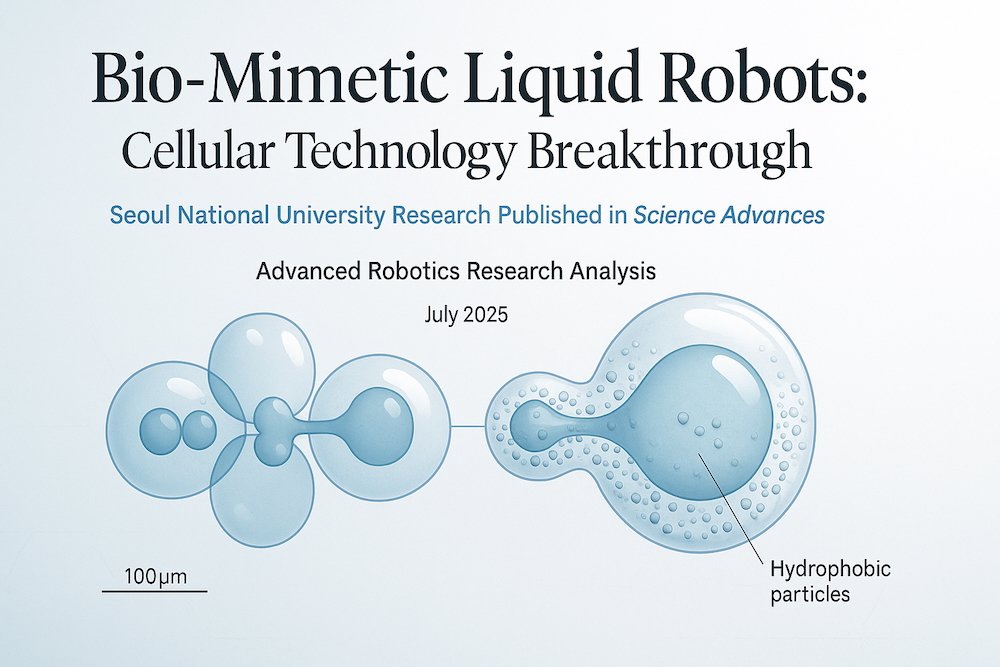Introduction: When Science Fiction Becomes Scientific Reality
The T-1000 Terminator from James Cameron’s iconic film is no longer confined to Hollywood imagination. South Korean scientists have achieved what many believed impossible: creating liquid robots that can merge, split, penetrate barriers, and heal themselves with remarkable precision. Moreover, this breakthrough promises to revolutionize medicine, industry, and human enhancement by 2027.
The Seoul National University team’s liquid robot technology represents a quantum leap in soft robotics. Additionally, while global superpowers focus on humanoid robots and artificial intelligence, South Korea has quietly developed a game-changing technology that could dominate the $2.3 billion soft robotics market. Furthermore, the implications extend far beyond laboratory experiments to reshape healthcare, manufacturing, and exploration.
The Breakthrough That Rewrites Robotics Fundamentals
Revolutionary Bio-Mimetic Design

The liquid robot developed by Seoul National University fundamentally challenges traditional robotics paradigms. Instead of rigid structures and mechanical components, this innovation mimics living cells with unprecedented accuracy, as analyzed in Mindplex Magazine’s educational overview. Moreover, the design combines liquid flexibility with solid structural stability through ingenious engineering.
The robot consists of a water core protected by a dense layer of hydrophobic particles, typically Teflon-based materials. This configuration enables the robot to maintain cohesion while allowing dramatic shape changes and self-healing capabilities. Additionally, the bio-mimetic approach draws inspiration from cellular behavior, enabling splitting, merging, and regeneration processes that parallel advances in artificial life and synthetic biology.
Professor Ho-Young Kim and his team at Seoul National University published their groundbreaking research in Science Advances on March 21, 2025. Furthermore, the collaboration with Gachon University’s Professor Jeong-Yun Sun has accelerated development beyond initial expectations. The peer-reviewed publication validates the technology’s scientific rigor and commercial potential, as detailed in TechXplore’s comprehensive analysis of the breakthrough.
Technical Specifications That Defy Physics

The liquid robot operates at microscopic scales, approximately the size of a rice grain, yet demonstrates capabilities that surpass much larger mechanical systems. The hydrophobic particle coating creates a protective barrier that maintains structural integrity under extreme conditions. Moreover, the water core enables payload transport and chemical reaction facilitation.
Ultrasound control systems provide precise navigation without requiring internal power sources or mechanical actuators. The external control mechanism eliminates battery requirements while enabling responsive movement across various surfaces. Additionally, the ultrasonic interface allows multiple robots to coordinate simultaneously for complex tasks.
The fabrication process involves advanced material science techniques, including controlled particle deposition and core liquid manipulation. Quality control measures ensure consistent performance across manufacturing batches. Furthermore, the production methodology supports scalability for commercial applications while maintaining precision standards.
Global Competition and Geopolitical Implications
South Korea’s Strategic Advantage
While China focuses heavily on humanoid robot manufacturing with plans to produce 10,000 units worth $1.14 billion in 2025, South Korea has identified a different pathway to robotics leadership. The liquid robot technology represents a strategic pivot toward specialized applications where traditional robots fail. Moreover, this approach positions South Korea as the leader in bio-mimetic soft robotics.
The Korean government’s National Research Foundation has designated liquid robotics as a national priority through 2027. This commitment includes substantial funding for research expansion and commercial development. Additionally, the strategic focus on liquid robotics complements South Korea’s strengths in materials science and precision manufacturing.
International patent applications are already underway, with Korea Patent Application 10-2404446 filed by SNU R&DB covering the fundamental fabrication process. This intellectual property protection ensures South Korean technological leadership while creating licensing opportunities. Furthermore, the patent strategy prevents easy replication by competing nations.
Competing International Efforts
The United States and European Union focus primarily on different soft robotics approaches, including 3D printable robots and magnetically driven systems. MIT, Harvard, and ETH Zurich pursue dielectric elastomer actuators and fiber composites without achieving the cellular mimicry demonstrated by Korean researchers. Moreover, these approaches lack the self-healing and splitting capabilities that define liquid robotics.
China’s robotics strategy emphasizes industrial automation and humanoid development rather than bio-mimetic soft systems. This focus creates an opportunity gap that South Korean technology exploits effectively. Additionally, Chinese research institutions have not demonstrated comparable liquid robot capabilities despite substantial robotics investments.
Japan’s advanced bio-hybrid micro-robots utilize polymer and gel-driven actuators but cannot match the liquid fusion technology developed by the Korean team. The Japanese approach requires more complex manufacturing and lacks the scalability potential of liquid robotics. Furthermore, Japanese systems cannot achieve the dramatic shape changes demonstrated by liquid robots.
Medical Applications Revolutionizing Healthcare
Targeted Drug Delivery Systems
The most promising near-term application involves targeted drug delivery within the human body. Liquid robots can navigate blood vessels, lymphatic systems, and tissue matrices to deliver medications precisely where needed. Moreover, the payload capacity allows for controlled release mechanisms and combination therapies impossible with conventional drug delivery, as highlighted in Tech360.tv’s analysis of biomedical applications.
Clinical trials are anticipated to begin by 2026, focusing initially on cancer treatment applications. The ability to penetrate tumor barriers and deliver chemotherapy directly to cancer cells could dramatically improve treatment outcomes while reducing systemic side effects. Additionally, this approach complements other revolutionary medical technologies like AI drug discovery platforms that are accelerating pharmaceutical development timelines.
Regulatory pathways through the FDA and EMA are being established, with the technology likely classified as a combination device-biologic. Biocompatibility testing and sterility validation protocols are currently under development. Furthermore, early engagement with regulatory authorities accelerates approval timelines for life-saving applications.
Minimally Invasive Surgical Procedures
Liquid robots enable surgical procedures previously impossible with traditional instruments. The ability to access confined spaces within the body opens new treatment possibilities for cardiovascular, neurological, and ophthalmological conditions. Moreover, self-healing capabilities reduce contamination risks during procedures.
Precision manipulation at cellular scales allows for targeted interventions without collateral tissue damage. Surgeons can potentially perform micro-repairs on blood vessels, nerve connections, and organ structures with unprecedented accuracy. Additionally, the liquid robots can remain in position for extended periods, providing sustained therapeutic effects.
Integration with existing surgical imaging systems enables real-time procedure guidance and monitoring. The ultrasound control mechanism is compatible with current medical ultrasound equipment, facilitating adoption in surgical suites. Furthermore, the minimally invasive approach reduces patient recovery times and healthcare costs significantly.
Diagnostic and Monitoring Applications
Beyond therapeutic uses, liquid robots offer revolutionary diagnostic capabilities. The robots can collect tissue samples, measure chemical concentrations, and detect disease markers from within the body. Moreover, real-time data transmission enables continuous health monitoring without invasive procedures.
Early disease detection becomes possible through molecular-level sensing capabilities built into the robot design. Cancer cells, infectious agents, and metabolic disorders can be identified before symptoms appear. Additionally, the robots can map disease progression and treatment responses with unprecedented detail.
Long-term monitoring applications include chronic disease management and preventive healthcare. Patients with diabetes, cardiovascular disease, or neurological conditions could benefit from continuous internal monitoring systems. Furthermore, the data collected supports personalized medicine approaches and precision treatment protocols.
Industrial and Environmental Applications
Industrial and Quality Control
Industrial applications leverage the liquid robots’ ability to navigate confined spaces and transport materials with precision. Manufacturing facilities can deploy these systems for quality inspection in areas inaccessible to human workers or traditional robots. Moreover, the self-healing properties ensure reliable operation in harsh industrial environments, as detailed in EE News Europe’s comprehensive coverage of industrial applications.
Chemical processing plants benefit from liquid robots’ ability to monitor reactions, transport catalysts, and clean equipment without human exposure to dangerous conditions. The robots can access narrow pipelines, reactor vessels, and filtration systems for maintenance and inspection. Additionally, real-time chemical analysis capabilities improve process control and safety.
Precision manufacturing applications include micro-scale assembly, surface treatment, and defect detection. Electronics manufacturing, pharmaceutical production, and aerospace components benefit from the robots’ accuracy and reliability. Furthermore, the technology enables quality control processes impossible with conventional inspection methods.
Environmental Cleanup and Restoration
Environmental applications address pollution cleanup in challenging locations where traditional methods prove inadequate. Liquid robots can navigate contaminated soil, groundwater systems, and industrial waste sites to neutralize pollutants through targeted chemical delivery. Moreover, the biological compatibility ensures minimal environmental impact during cleanup operations.
Ocean cleanup efforts benefit from the robots’ ability to operate in saltwater environments while targeting specific pollutants. Microplastics, chemical contaminants, and oil spills can be addressed through coordinated robot swarms. Additionally, the technology enables cleanup in sensitive marine ecosystems without disrupting wildlife.
Soil remediation applications include agricultural land restoration and industrial site cleanup. The robots can deliver beneficial microorganisms, neutralizing agents, and nutrients directly to affected areas. Furthermore, real-time monitoring capabilities track cleanup progress and environmental recovery metrics.
Space Exploration and Extreme Environments
Space applications leverage the robots’ ability to operate without external power sources and withstand extreme conditions. Planetary exploration missions can deploy liquid robots to investigate subsurface environments, caves, and geological formations inaccessible to conventional rovers. Moreover, the self-repair capabilities ensure mission continuity despite equipment damage.
Extraterrestrial mining operations benefit from the robots’ precision and adaptability in unknown environments. Resource extraction, sample collection, and equipment maintenance become possible in locations where human presence is impossible. Additionally, the technology enables autonomous operations with minimal Earth-based control requirements.
Deep-sea exploration applications include ocean floor mapping, geological surveys, and biological specimen collection. The pressure resistance and corrosion immunity of liquid robots enable operations at depths exceeding current technological limits. Furthermore, the technology opens new frontiers for marine science and resource discovery.
Economic Impact and Market Transformation
Investment Landscape and Funding
The global soft robotics market is projected to reach $2.3 billion by 2030, with liquid robotics expected to capture 5-10% market share through specialized applications. Investment interest is rapidly growing as the technology demonstrates commercial viability across multiple industries. Moreover, the unique capabilities create new market categories previously impossible to address.
Venture capital funding for liquid robotics startups is accelerating, particularly in biomedical applications. Pharmaceutical companies are actively seeking partnerships for drug delivery platform development. Additionally, industrial automation companies recognize the potential for revolutionary manufacturing applications.
Government funding continues through South Korea’s national soft robotics initiative, ensuring continued research and development support through 2027. International collaboration agreements are being negotiated to expand research capabilities and market access. Furthermore, licensing opportunities generate revenue streams while maintaining technological leadership.
Job Creation and Economic Disruption
The liquid robotics revolution creates new employment categories in microfabrication, biomaterials engineering, and control systems design. Educational institutions are developing specialized curricula to train the next generation of liquid robotics engineers. Moreover, the interdisciplinary nature of the field attracts talent from multiple scientific domains.
Traditional industries face potential disruption as liquid robotics enables previously impossible applications. Industrial inspection, chemical cleanup, and medical logistics may experience significant automation impacts. Additionally, new service industries emerge around robot deployment, maintenance, and optimization.
Manufacturing economics shift as liquid robotics reduces production costs and improves quality control. The technology enables domestic production competitiveness in high-wage countries through automation advantages. Furthermore, supply chain optimization through precision logistics creates economic efficiencies across industries.
Commercial Partnerships and Licensing
Korean biotechnology and pharmaceutical companies are establishing partnerships to accelerate liquid robot commercialization. Early adopters gain competitive advantages through exclusive access to transformative technologies. Moreover, international licensing agreements expand market reach while generating revenue for continued research.
Technology transfer agreements with medical device manufacturers facilitate rapid commercial deployment. Existing regulatory relationships and distribution networks accelerate market penetration. Additionally, strategic partnerships reduce development costs and risks for all parties involved.
Industrial automation companies are integrating liquid robotics into comprehensive manufacturing solutions. The combination of traditional and liquid robotics creates synergistic capabilities exceeding individual technology limitations. Furthermore, cross-industry applications generate multiple revenue streams from single technology platforms.
Creating Viral Content About Liquid Robotics
Video Production and Educational Content
The visual appeal of liquid robotics makes it ideal for AI video creation platforms that can demonstrate the technology’s remarkable capabilities. Time-lapse footage of robots merging, splitting, and navigating obstacles captivates audiences while educating about scientific breakthroughs. Moreover, animated explanations help viewers understand complex concepts through engaging visual narratives, as demonstrated in our viral short video showcasing the breakthrough’s incredible potential.
Professional video editing tools like Pictory enhance scientific content with dramatic effects that highlight the technology’s revolutionary nature. Additionally, comparison videos showing liquid robots versus traditional alternatives demonstrate clear advantages and applications.
Educational content creation benefits from AI avatar technology that can explain complex scientific concepts in multiple languages and formats. International audiences gain access to cutting-edge research through accessible presentations. Furthermore, personalized educational content adapts to different knowledge levels and interests.
Social Media Strategy and Audience Engagement
Liquid robotics content performs exceptionally well across social media platforms due to its visual drama and scientific credibility. The bio-mimetic comparison provides immediate context while generating emotional responses from audiences. Moreover, the medical applications create personal relevance that drives sharing and discussion.
Newsletter platforms like Beehiiv enable creators to build engaged communities around emerging technologies and scientific breakthroughs. Regular updates about liquid robotics developments maintain subscriber interest while establishing thought leadership. Additionally, exclusive insights and analysis create premium content value.
Educational institutions and researchers can leverage online learning platforms to teach liquid robotics concepts and applications. The interdisciplinary nature appeals to students in engineering, medicine, and materials science. Furthermore, practical applications demonstrate real-world relevance and career opportunities.
Safety Considerations and Ethical Implications
Biosafety Protocols and Medical Standards
Medical applications require rigorous biosafety protocols to ensure patient safety and treatment efficacy. Biocompatibility testing for hydrophobic particles and liquid cores must meet international pharmaceutical standards. Moreover, sterility maintenance throughout manufacturing and deployment processes demands specialized quality control systems.
Regulatory oversight addresses potential dual-use concerns where therapeutic technologies could be misused for harmful purposes. International cooperation on safety standards prevents dangerous applications while enabling beneficial uses. Additionally, transparent development processes build public trust and regulatory confidence.
Environmental impact assessments evaluate the ecological effects of liquid robot deployment and disposal. Biodegradable materials and safe disposal protocols minimize long-term environmental consequences. Furthermore, lifecycle analysis ensures sustainable development practices throughout the technology’s commercial lifespan.
Privacy and Security Considerations
Data collection capabilities of medical liquid robots raise privacy concerns requiring robust protection measures. Patient information gathered during diagnostic and therapeutic procedures needs encryption and access controls. Moreover, international data protection regulations must be incorporated into system designs from the beginning.
Cybersecurity measures protect liquid robot control systems from unauthorized access or malicious manipulation. Secure communication protocols and authentication systems prevent dangerous interference with medical or industrial applications. Additionally, VPN services protect research communications and intellectual property from industrial espionage during development phases.
Surveillance applications require careful regulation to prevent abuse while enabling legitimate security and monitoring uses. Clear guidelines distinguish acceptable monitoring from privacy violations. Furthermore, democratic oversight ensures technology serves public interests rather than authoritarian control.
Technology Integration and Future Development
Artificial Intelligence and Machine Learning
Integration with artificial intelligence systems enables autonomous decision-making and adaptive behavior in liquid robots. Machine learning algorithms optimize navigation, task execution, and problem-solving capabilities. Moreover, swarm intelligence applications coordinate multiple robots for complex missions exceeding individual robot capabilities.
Sensor integration provides real-time environmental data for intelligent responses to changing conditions. Chemical sensors, imaging systems, and communication devices enhance robot functionality while maintaining miniaturization requirements. Additionally, edge computing capabilities enable rapid response without external communication delays.
Predictive maintenance algorithms optimize robot performance and prevent failures during critical missions. Machine learning analysis of operational data identifies patterns and optimizes procedures continuously. Furthermore, artificial intelligence enables natural language interfaces for simplified human-robot interaction.
Materials Science Advancement
Advanced materials research enhances liquid robot capabilities through improved particles, cores, and coatings. Smart materials respond to environmental stimuli for enhanced functionality and control. Moreover, biodegradable options enable temporary applications without long-term environmental impact.
Nanotechnology integration creates multifunctional particles that combine structural, sensing, and communication capabilities. Programmable materials adapt properties based on mission requirements and environmental conditions. Additionally, self-assembling systems reduce manufacturing complexity while improving performance reliability.
Biomimetic materials draw inspiration from natural systems to enhance robot capabilities and efficiency. Cell membrane analogs, protein-based actuators, and biological sensing mechanisms create more sophisticated liquid robots. Furthermore, these advances complement breakthroughs in superconductor technology and other revolutionary materials that enable new functionalities previously impossible in robotics applications.
Conclusion: Preparing for the Liquid Robot Revolution
The liquid robot revolution represents more than a scientific breakthrough; it marks the beginning of a new era in human-machine interaction and technological capability. South Korea’s leadership in this field demonstrates how focused research and strategic investment can create transformative technologies that reshape entire industries.
The medical applications alone justify the massive investment in liquid robotics research and development. By 2027, patients worldwide may benefit from precision drug delivery, minimally invasive procedures, and continuous health monitoring impossible with current technology. Moreover, the industrial and environmental applications promise to solve problems that have challenged humanity for decades.
The geopolitical implications extend beyond technological competition to influence national security, economic competitiveness, and international cooperation. Countries that embrace liquid robotics early gain advantages in healthcare, manufacturing, and environmental protection that compound over time. Furthermore, the technology creates new diplomatic opportunities through beneficial international collaboration.
As we stand on the threshold of the liquid robot age, preparation becomes essential for individuals, businesses, and governments. Educational systems must adapt to train the workforce for liquid robotics careers. Medical professionals need training in new diagnostic and therapeutic capabilities. Furthermore, regulatory frameworks must evolve to govern emerging applications while enabling beneficial innovation.
The T-1000 Terminator has evolved from science fiction to scientific reality, but unlike its Hollywood counterpart, real liquid robots promise to heal rather than harm, to build rather than destroy, and to enhance human capabilities rather than replace them. The future is liquid, and it arrives sooner than we ever imagined.

Pingback: Stanford's CRISPR-GPT: AI Revolutionizes Gene Editing 2025